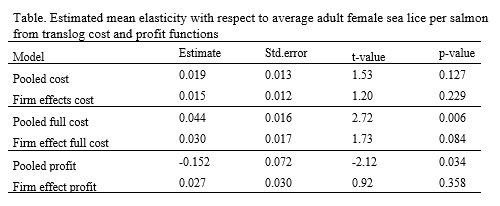GROUP REGULATION AND ENVIRONMENTAL OUTCOME: EVIDENCE FROM ZONAL OUTPUT RESTRICTION IN NORWEGIAN AQUACULTURE
Introduction
Sea lice parasite has become a main environmental challenge for salmon farming. Sea lice creates concerns both for the welfare of farmed fish and the stocks of wild salmonids, as it can lead to increased mortality both for farmed salmon and wild salmon. In Norway sea lice are regulated both at the farm level and production area level, the latter through the so-called “traffic light system”. A sea lice regulation at the farm site level was introduced in 2013. In 2017, the government of Norway in addition introduced the traffic light system (TLS), that divides the Norwegian coast into 13 aquaculture production zones and labels them ‘Green’, ‘Yellow’, or ‘Red’ based on the estimated sea-lice-induced mortality rates on the wild stock. If a production zone is labeled ‘Green’/‘Red’, production capacity should increase/decrease by 6% whereas ‘Yellow’ means the current level of output should be maintained.
The research questions we ask are as follows: (1) Does output restriction improve environmental outcomes? Even though it seems that output restriction would automatically improve environmental outcomes, Helfand (1991) analytically outlined that the effect is not straightforward. (2) If output restriction improves environmental outcomes, does the improvement come at the cost of economic outcomes such as firms’ efficiency loss and/or reduction in profits?
Empirical analysis
We use two data sources to empirically analyze the above research questions: (1) Publicly available weekly data on lice counts at farm level and other variables by The Norwegian Food Safety Authority (NFSA), the Norwegian Veterinary Institute and the Directorate of Fisheries. (2) Firm-level annual economic data (production data) from the Norwegian Directorate of Fisheries
For the first research question we have two complementary empirical strategies to establish a clear causal relationship between the TLS and environmental and economic outcomes, and obtain unbiased estimates. First, we have a regression discontinuity design in time (RDiT), where we explore the temporal aspect using ‘week’ as a running variable and the treatment date (week) as a threshold. When we estimate econometric RDiT models on the lice count
we find that TLS leads to a significant reduction in adult female sea lice count.
Second, we use a Difference in difference (DiD) estimation approach to explore the spatial aspect by exploiting variations in the intensity of output restriction. When we estimate econometric DID models on the lice count
we find that the introduction of TLS leads to a significant reduction in adult female sea lice count.
To address the second research question on the economic effect of sea lice restriction we undertake an econometric analysis of production costs and profits. We estimate cost functions and profit functions which enable us to separate the effects of input prices, scale economies, technical change and external effects on production costs in salmon farming. The results are mixed. Overall, an increase in sea lice prevalence is associated with an increase in production costs. However, the effect is only statistically significant when full production costs is the dependent variable. For profits the effect of an increase in sea lice prevalence is significantly negative when we estimate a pooled model, i.e. lower sea lice prevalence is associated with higher profits, but not significantly different from zero when we include firm-specific effects in the profit function.
Conclusions
Using unique data from this policy experiment, we investigate whether sea lice regulation improves environmental outcomes and/or affects firms’ cost efficiency and profit. We take advantage of spatial and temporal variation in the regulation’s implementation to show that a threat of zonal output restriction did reduce the prevalence of sea lice in all production zones across different specifications. Difference-in-difference estimations show that a greater reduction in the prevalence of sea lice is observed in ‘Red’ labeled zones compared to ‘Green’ and ‘Yellow’ zones. Evidence from estimation of cost functions and profit functions indicate that the introduction of the TLS resulted in cost increases and a reduction in profit.
